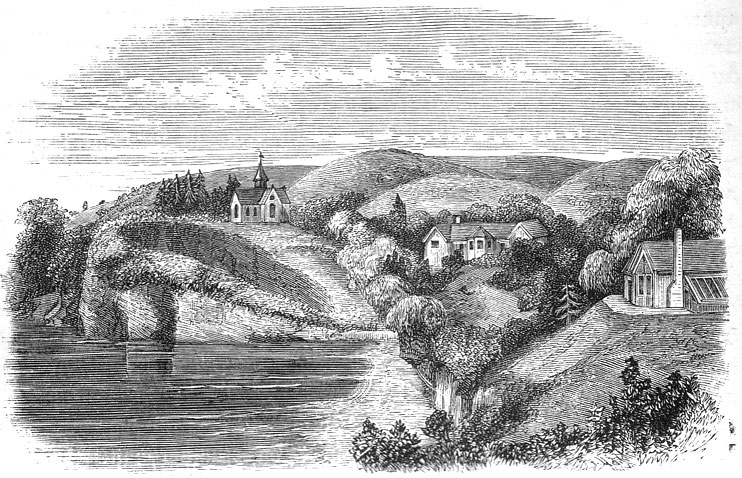

THE little sketch which accompanies this paper represents a spot which can hardly fail to have great attraction to the New Zealand church historians of the future; and though we have still with us, thank God, those who contributed to give the place its peculiar interest, it may yet be worth while to offer this sketch to your readers, and to point out to them what it is which, even more than the sweet seclusion of the little bay, draws visitors to Tararua.
This little spot is most intimately associated with the earliest history of our Church as an organized body in New Zealand.
Tararua, almost ere Auckland was, became the chosen home of Chief Justice Sir William Martin, than whom I suppose no one has devoted talents and learning and piety more perseveringly and unostentatiously to the service of the church in the colony. His picturesque wooden dwelling, which occupies the centre of the engraving, is substantially that which he brought out with him from England more than thirty years ago. I cannot stay to describe it; but it is surrounded by a garden, in which the roses and woodbine and laburnum of England are blended with the veronicas and beautiful shrubs of New Zealand, and this stretches down by a succession of gentle slopes to the shore; whilst on [598/599] the one hand is the equally charming retreat of his professional brother Mr. Swainson, the late Attorney-General for New Zealand, and now the joint possessor with Sir William of flower-scented Tararua; and on the other, is the little Church of St. Stephen, with its cemetery attached, the sanctuary in which many prayers were offered by the infant Church to its Divine Protector.
It was to this lovely spot that Sir William Martin welcomed Bishop Selwyn when he entered upon his labours in the year 1841. Sir William had indeed only preceded the Bishop for a few months; and when the vessel which had brought the latter arrived in Auckland harbour, it was to Tararua he desired to be taken. I had the happiness of having pointed out to me by Sir William himself as nearly as possible the exact spot upon which, having landed from the boat, this Apostle of New Zealand and the Southern Seas, imitating the Apostle of the Gentiles, kneeled down upon the shore and prayed.
The Bishop subsequently adopted this neighbourhood for the episcopal residence; and Bishopscourt, built, however, only towards the end of the Bishop of New Zealand's oversight of the colony, is within a few minutes' walk of Tararua; thus the Bishop was enabled to avail himself of the calm judgment and careful research of the retired man of law in the long and anxiously-considered subject of the constitution of the island Church. The time came at length when the declarations of the highest authorities at home as to the relation of the State to the Church in the colonies having made apparent the necessity of rules for organisation and self-government on the part of the Church itself, a meeting was convened for the purpose of elaborating such a system in the little chapel of St. Stephen, seen in the sketch. Here day after day met together the godly and well-learned men whom God had raised up to be the nursing fathers of His Church.
These, first joining together in prayer, discussed with a spirit of calmness and singleness of purpose the outlines of the proposed constitution, striving ever to keep in view and properly to adjust the requirements of the present with the principles which had prevailed in the past. Thus was prepared the draft of the constitution which was afterwards presented to the first General Synod of the New Zealand Church for its adoption, and which, with but few additions and amendments upon subsequent occasions, has won its way to acceptance, that, although founded upon the principle of voluntary association, and having no authority over any one who choose to hold aloof from its sway, it has now received the universal acknowledgement of the members of our Church in the colony. Its provisions are carried out with alacrity, and its regulations submitted to with cheerfulness.